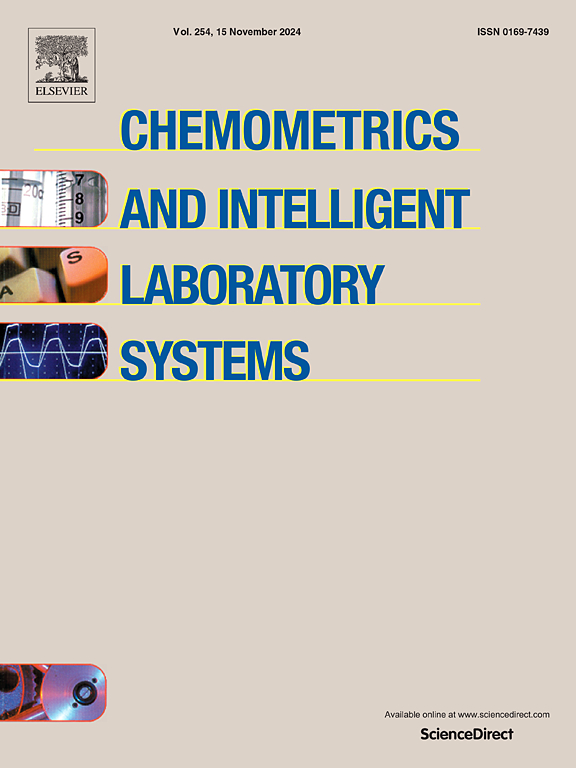Multivariate image analysis for assessment of textural attributes in transglutaminase-reconstituted meat
IF 3.7
2区 化学
Q2 AUTOMATION & CONTROL SYSTEMS
Chemometrics and Intelligent Laboratory Systems
Pub Date : 2024-11-26
DOI:10.1016/j.chemolab.2024.105280
引用次数: 0
Abstract
The control of sensorial textural attributes has high interest to the meat industry focused on the recovery of the value of meat by-products by developing reconstituted meat pieces with added sensory and nutritional values. Sensorial analysis of foods is still a quite subjective methodology, highly dependent of a well-trained team of inspectors, which is simulated by textural analysis in order to measure objective physical properties. This work presents a non-destructive and contactless experimental methodology to predict the physical properties of a reconstituted meat product, based on integrating multispectral imaging and multivariate image analysis (MIA). The experiment was based on reconstituting grounded meat with different concentrations of transglutaminase (0.1, 1, 3, 6 and 10 %), from which textural properties and multispectral imaging data were measured. Multispectral images (UV, VIS and NIR wavelengths) were processed with chemometric procedures to obtain the distribution maps and score images, from which different blocks of features were extracted to generate feature vectors (basic statistics and co-occurrence matrix) for each image. The obtained regression models built with these features predicted all physical properties of the meat with Q2 > 0.90, after feature selection using VIPs. These results evidenced the capacity of multispectral imaging, combined with chemometric procedures, to capture the variability of physical properties induced by transglutaminase in a derivate meat product. It could represent the base of a potential contactless application for a meat industrial inspection, where work environments have strong hygienic requirements.
多变量图像分析评价谷氨酰胺转胺酶重组肉的纹理属性
通过开发具有附加感官和营养价值的重组肉片来回收肉类副产品价值的肉类工业对感官质地属性的控制具有很高的兴趣。食品的感官分析仍然是一种非常主观的方法,高度依赖于训练有素的检查员团队,这是通过质地分析来模拟的,以测量客观的物理特性。本研究提出了一种基于多光谱成像和多变量图像分析(MIA)的非破坏性和非接触式实验方法来预测重构肉制品的物理特性。实验是基于用不同浓度的谷氨酰胺转胺酶(0.1、1、3、6和10%)重构碎肉,并测量其纹理特性和多光谱成像数据。采用化学计量学方法对多光谱图像(UV、VIS和NIR波长)进行处理,得到图像的分布图和评分图,并从中提取不同的特征块,生成每张图像的特征向量(基本统计量和共现矩阵)。利用这些特征建立的回归模型用Q2 >预测了肉的所有物理性质;0.90,使用vip进行特征选择后。这些结果证明了多光谱成像与化学计量程序相结合的能力,可以捕获转谷氨酰胺酶在衍生肉制品中引起的物理特性的可变性。它可能代表了一种潜在的非接触式应用的基础,用于工作环境对卫生有很强要求的肉类工业检查。
本文章由计算机程序翻译,如有差异,请以英文原文为准。
求助全文
约1分钟内获得全文
求助全文
来源期刊
CiteScore
7.50
自引率
7.70%
发文量
169
审稿时长
3.4 months
期刊介绍:
Chemometrics and Intelligent Laboratory Systems publishes original research papers, short communications, reviews, tutorials and Original Software Publications reporting on development of novel statistical, mathematical, or computer techniques in Chemistry and related disciplines.
Chemometrics is the chemical discipline that uses mathematical and statistical methods to design or select optimal procedures and experiments, and to provide maximum chemical information by analysing chemical data.
The journal deals with the following topics:
1) Development of new statistical, mathematical and chemometrical methods for Chemistry and related fields (Environmental Chemistry, Biochemistry, Toxicology, System Biology, -Omics, etc.)
2) Novel applications of chemometrics to all branches of Chemistry and related fields (typical domains of interest are: process data analysis, experimental design, data mining, signal processing, supervised modelling, decision making, robust statistics, mixture analysis, multivariate calibration etc.) Routine applications of established chemometrical techniques will not be considered.
3) Development of new software that provides novel tools or truly advances the use of chemometrical methods.
4) Well characterized data sets to test performance for the new methods and software.
The journal complies with International Committee of Medical Journal Editors'' Uniform requirements for manuscripts.

 求助内容:
求助内容: 应助结果提醒方式:
应助结果提醒方式:


